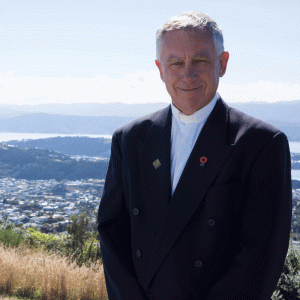July 2016 | Hōngongoi
Cardinal John Dew
Kia ora tātou
The kaupapa (theme) for Māori Language Week ‒ te wiki o Te Reo Māori, 4‒10 July this year, is ākina to reo ‒ behind you all the way, which is about using Te Reo Māori to support people, to inspire and to cheer them on, as we all do at sporting events. Our Church should always be about supporting people, inspiring and cheering them on and in particular Tangata Whenua, the People of the Land.
Look up the website (www.tetaurawhiri.govt.nz) for information about Māori Language week and you will discover these words: ‘Māori Language Week 2016 is going to be positive, relevant, energetic, fun and exciting! It will show New Zealand that there is a place for the Māori language in our stadiums, on our sports fields, in the news and the ever-growing realm of social media. It will also show the country that Te Reo Māori is a language for all New Zealanders.’
Te Reo Māori is a language for all New Zealanders. It is a language we use in our liturgical celebrations, and it is right that we do so. When the new Missal was published in 2010, I signed a letter as the then President of the New Zealand Catholic Bishops Conference. That letter reads:
‘We, the Bishops of Aotearoa New Zealand, invite you not only to take the Roman Missal in your hands, but over the coming years, to plant the new texts, English and Māori, deep in your hearts, so that they may, in time, become as familiar to you and loved by you, as those you leave behind. This is the Church’s taonga to you. Take it. Treasure it. Pray it.’
The Bishops wanted, and I want you in the Archdiocese of Wellington, to take these Māori texts, to treasure them and pray them. We owe that to our Māori sisters and brothers. Sometimes people ask why we use Māori in our liturgy. The answer is simple: it is an official language of New Zealand – the more we use Te Reo Māori in our liturgies the more our Māori sisters and brothers will feel comfortable and at home in our churches. Ten years ago, in 2006, at our Archdiocesan Synod, we made a commitment to use some Māori in our liturgies, such as the sign of the cross, a simple welcome, and maybe the final blessing, but we can and must do more.
Almost 30 years ago, on 22 November 1986, Saint Pope John Paul II said at the Auckland Domain: ‘A rich culture already existed in your country before the arrival of the Church or the many immigrants: the culture of the Māori people. This culture has in turn been strengthened and enriched by the uplifting and purifying power of the Gospel.
The strengths of Māori culture are often the very values which modern society is in danger of losing: an acknowledgment of the spiritual dimension in every aspect of life: a profound reverence for nature and the environment; a sense of community, assuring every individual that he or she belongs; loyalty to family and a great willingness to share; an acceptance of death as part of life and a capacity to grieve and mourn the dead in a human way.’
Language is an essential building block of culture. Saint John Paul II reminded New Zealand of the strengths of Māori culture. One of the ways we can all benefit from Māori culture is by embracing the gift of Te Reo Māori in our liturgies. The letter I have referred to above concludes by saying: ‘A taonga kahurangi, a precious gift, has been given to you by the Church. Take it. Treasure it. Pray it.’
My plea to you in this te wiki o Te Reo Māori is to do just that. Take it. Treasure it. Pray it. If we all do that we will be living the theme of this week ākina te reo – we will be with our Māori sisters and brothers in faith, we will be behind each other all the way, supporting, inspiring and cheering one another on.
Faith and Inculturation
The following paragraphs are from the Vatican’s International Theological Commission’s 1988 document on Faith and Inculturation.
‘The International Theological Commission has had, on several occasions, the opportunity to reflect on the relationship between faith and culture. In 1984 it spoke directly on the inculturation of faith in its study on the mystery of the Church, which it produced with a view to the extraordinary synod of 1985. For its part, the Pontifical Biblical Commission held its 1979 plenary session on the theme of the inculturation of faith in the light of Scripture. [1]
Today the International Theological Commission intends to continue this reflection in a more profound and systematic manner on account of the importance assumed by this theme of the inculturation of faith throughout the Christian world and on account of the insistence with which the Church’s magisterium has considered this theme since the Second Vatican Council. [2]
Pope John Paul II himself has taken to heart in a special manner the evangelisation of cultures: In his view, the dialogue of the Church and of cultures assumes a vital importance for the future of
the Church and of the world. To assist him in this great work, the Holy Father has created
a specialised curial body: the Pontifical Council for Culture. [4]
Relying on the conviction that “the incarnation of the Word was also a cultural incarnation”, the pope affirms that cultures, analogically comparable to the humanity of Christ in whatever good they possess, may play a positive role of mediation in the expression and extension of the Christian faith. [5]
The Vatican’s International Theological Commission document on Faith and Inculturation (1988) can be found on the Vatican website (tinyurl.com/faith-and-inculturation).
